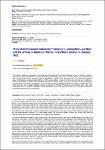‘A Hundred Thousand Welcomes’? Unionism, nationalism, partition and the arrival of American forces in Northern Ireland in January 1942
| dc.contributor.author | Topping, Simon | |
| dc.date.accessioned | 2018-01-16T15:29:46Z | |
| dc.date.accessioned | 2019-05-16T13:30:17Z | |
| dc.date.available | 2018-01-16T15:29:46Z | |
| dc.date.issued | 2018-01-02 | |
| dc.identifier.issn | 1479-4012 | |
| dc.identifier.issn | 1754-1018 | |
| dc.identifier.uri | http://hdl.handle.net/10026.1/14063 | |
| dc.description.abstract |
This article analyses the responses of unionists and nationalists to the arrival of American forces in Northern Ireland in January 1942, and how traditional narratives, particularly those dealing with links to the United States, were reordered in the light of this development. For unionists, it was an opportunity to demonstrate a commitment to the war effort and reinforce a sense of Britishness, particularly after efforts in 1940 to end partition in return for Éire’s entry into the war. In addition, it offered the possibility to forge a bilateral relationship with the United States, by being a good ally and resurrecting links between Ulster and America. Nationalists saw the arrival as America legitimising partition and were outraged that Éire’s government was not consulted (despite having no jurisdiction). Ordinary Protestants and Catholics were much more phlegmatic about the political implications of the Americans’ arrival, and after the initial burst of publicity, subsequent deployments garnered much less publicity. | |
| dc.format.extent | 81-100 | |
| dc.language | en | |
| dc.language.iso | en | |
| dc.publisher | Taylor & Francis (Routledge) | |
| dc.relation.replaces | http://hdl.handle.net/10026.1/10593 | |
| dc.relation.replaces | 10026.1/10593 | |
| dc.relation.replaces | 10026.1/12898 | |
| dc.relation.replaces | http://hdl.handle.net/10026.1/12898 | |
| dc.relation.replaces | 10026.1/12898 | |
| dc.relation.replaces | http://hdl.handle.net/10026.1/12898 | |
| dc.subject | Northern Ireland | |
| dc.subject | US forces | |
| dc.subject | World War Two | |
| dc.title | ‘A Hundred Thousand Welcomes’? Unionism, nationalism, partition and the arrival of American forces in Northern Ireland in January 1942 | |
| dc.type | journal-article | |
| dc.type | Journal Article | |
| plymouth.issue | 1 | |
| plymouth.volume | 16 | |
| plymouth.publisher-url | https://www.tandfonline.com/doi/abs/10.1080/14794012.2018.1423605 | |
| plymouth.publication-status | Published | |
| plymouth.journal | Journal of Transatlantic Studies | |
| dc.identifier.doi | 10.1080/14794012.2018.1423605 | |
| pubs.merge-from | 10026.1/12898 | |
| pubs.merge-from | http://hdl.handle.net/10026.1/12898 | |
| pubs.merge-from | 10026.1/12898 | |
| pubs.merge-from | http://hdl.handle.net/10026.1/12898 | |
| plymouth.organisational-group | /Plymouth | |
| plymouth.organisational-group | /Plymouth/Faculty of Arts, Humanities and Business | |
| plymouth.organisational-group | /Plymouth/REF 2021 Researchers by UoA | |
| plymouth.organisational-group | /Plymouth/REF 2021 Researchers by UoA/UoA28 History | |
| plymouth.organisational-group | /Plymouth/Users by role | |
| plymouth.organisational-group | /Plymouth/Users by role/Academics | |
| dcterms.dateAccepted | 2018-01-05 | |
| dc.rights.embargodate | 2019-7-15 | |
| dc.identifier.eissn | 1754-1018 | |
| dc.rights.embargoperiod | Not known | |
| rioxxterms.versionofrecord | 10.1080/14794012.2018.1423605 | |
| rioxxterms.licenseref.uri | http://www.rioxx.net/licenses/all-rights-reserved | |
| rioxxterms.type | Journal Article/Review |



